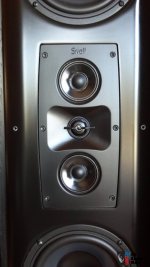Dave,
Curious what crossover orders you used in the XA series on the MTM.
(your profile pic is an XA Ref if I'm not mistaken?,.. outstanding speaker!)
In some of the D'Appolito designs I can hear a phasing mismatch between the mids and tweeters,... but I did not witness the same of the XA's.
Yes, that is the central array of the XA Ref.
2nd order electrical on both sides but I remember that some asymmetry of corner shape gave the best blend and polars.
Spacing is key with these arrays. If you can get the center cluster tight enough for the crossover point you can get wide/smooth vertical response. I am currently working on a 7 element log spaced array that is absolutely lobe free and constant directivity over 6 Octaves.
Regards,
David
Yes, that is the central array of the XA Ref.
2nd order electrical on both sides but I remember that some asymmetry of corner shape gave the best blend and polars.
Spacing is key with these arrays. If you can get the center cluster tight enough for the crossover point you can get wide/smooth vertical response. I am currently working on a 7 element log spaced array that is absolutely lobe free and constant directivity over 6 Octaves.
Regards,
David
Dave, I am curious, did you design the XA? If so, how did you deside the geometry of the tweeter flare? Is cubic better than conic when it comes to dispersion?
Attachments
I am currently working on a 7 element log spaced array that is absolutely lobe free and constant directivity over 6 Octaves.
If my ears could drool over this, they would!
how did you deside the geometry of the tweeter flare?
If I could add to this, what was your design consideration with the waveguide? Were you going for improved dispersion, time-alignment, etc?
Remember that we are making an array with moderate directivity based on crossing over to units of ever expanding spacing (going down in frequency). At the highest frequencies, rather than having an over and under element giving some directivity we only have a single central element. So adding a waveguide is a way of creating some directivity to best match the directivity of the rest of the units.
That is, a tweeter waveguide gives directivity to match the rest of the array.
The flare is essentially conical with straight sides in the horizontal plane. Vertically it is allowed to narrow a little more and this helps get the tightest spacing from M to T to M to prevent lobing.
I think I used construction paper mockups at first and then wood and clay mockups to optimize the flare.
Regards,
David
That is, a tweeter waveguide gives directivity to match the rest of the array.
The flare is essentially conical with straight sides in the horizontal plane. Vertically it is allowed to narrow a little more and this helps get the tightest spacing from M to T to M to prevent lobing.
I think I used construction paper mockups at first and then wood and clay mockups to optimize the flare.
Regards,
David
Thank you Dave!,... such a pleasure to converse with you again.
I have to admit, I don't have a lot of personal construction experience with MTM's, and being able to discuss them with one of my fave speaker designers is, well, priceless.
Generally speaking,
It seems like MTM designs are less susceptible to the lobe tilt inherent in a MT design if acoustical centers are unaligned in both cases.
But would a time alignment issue exist on an MTM if the drivers acoustical centers are not aligned as it does on an MT?,.... I should think so.
Interesting,...I used much the same method on the one-offs I created. Construction board, modeling clay, poplar (easy to whittle but not too soft), fiberglass resin. Good fun, really! 🙂
Best, Chris
I have to admit, I don't have a lot of personal construction experience with MTM's, and being able to discuss them with one of my fave speaker designers is, well, priceless.
Generally speaking,
It seems like MTM designs are less susceptible to the lobe tilt inherent in a MT design if acoustical centers are unaligned in both cases.
But would a time alignment issue exist on an MTM if the drivers acoustical centers are not aligned as it does on an MT?,.... I should think so.
I think I used construction paper mockups at first and then wood and clay mockups to optimize the flare.
Interesting,...I used much the same method on the one-offs I created. Construction board, modeling clay, poplar (easy to whittle but not too soft), fiberglass resin. Good fun, really! 🙂
Best, Chris
- Status
- Not open for further replies.
